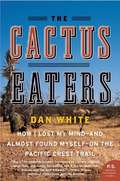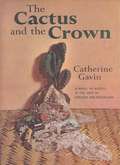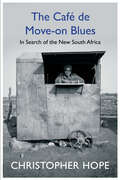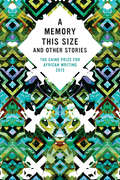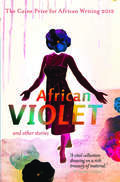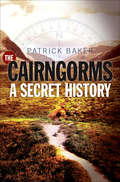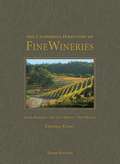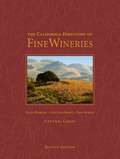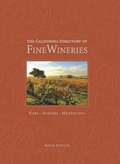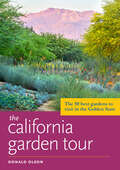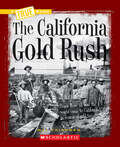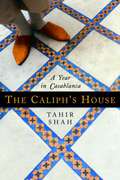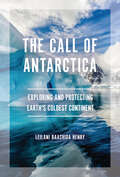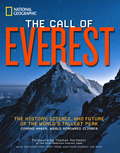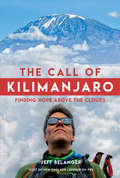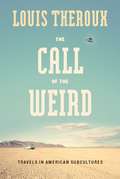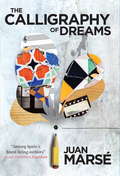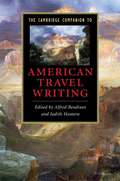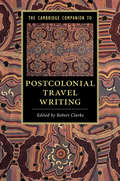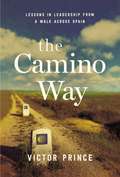- Table View
- List View
The Cactus Eaters: How I Lost My Mind -- and Almost Found Myself -- on the Pacific Crest Trail
by Dan WhiteThe Pacific Crest Trail stretches from Mexico to Canada, a distance of 2,650 grueling, sun-scorched, bear-infested miles. When Dan White and his girlfriend announced their intention to hike it, Dan's parents--among others--thought they were nuts. How could two people who'd never even shared an apartment together survive six months in the desert with little more than a two-person tent and some trail mix? But when these addled adventurers, dubbed "the Lois and Clark Expedition" by their benevolent trail-guru, set out for the American wilderness, the hardships of the trail--and one delicious-looking cactus--test the limits of love and sanity.
The Cactus and the Crown: A Novel Of Mexico In The Days Of Carlota And Maximilian
by Catherine GavinA VIVID AND DRAMATIC STORY OF LOVE, CONFLICT AND REBELLION IN NINETEENTH CENTURY MEXICOIn the late 1860’s the royal families of Europe collaborated with the French in an ingenious plan to take over Mexico. They set up Maximilian von Hapsburg and his wife Carlóta as the Emperor and Empress of Mexico. In accepting this crown Maximilian bowed to the ambitions of his wife, a disturbed yet disturbingly beautiful woman. Unfortunately Maximilian was inept as a ruler and the whole adventure ended in disaster as the people of Mexico, led by Juarez, rose to overthrow him.Told against a background of imperial splendour and ever increasing tension, this novel has three themes—the making of a girl into a woman, the making of a man into a doctor, and the making of a nation—developed through the stories of two young Americans, Dr. Andrew Lorimer and his sister Sally, and Pierre Franchet, a soldier in the French Expeditionary Corps.The Cactus and the Crown, which was first published in 1962, is an exceptionally well-researched historical novel from Catherine Gavin, set during the beginnings of the Mexican nation, when Maximilian was Emperor and the guerrilla forces of Benito Juarez were fighting against French troops.
The Cafe de Move-on Blues: In Search of the New South Africa
by Christopher HopeIn White Boy Running, Christopher Hope explored how it felt and looked to grow up in a country gripped by an 'absurd, racist insanity'. On a road trip thirty years later, Hope goes in search of today's South Africa; post the evils of apartheid, but also post the dashed hopes and dreams of Mandela, of a future when race and colour would not count. He finds a country still in the grip of a ruling party intent only on caring for itself, to the exclusion of all others; a country where racial divides are deeper than ever. As the old imperial idols of Cecil Rhodes and Paul Kruger are literally pulled from their pedestals in a mass yearning to destroy the past, Hope ponders the question: what next? Framed as a travelogue, this is a darkly comic, powerful and moving portrait of South Africa—an elegy to a living nation, which is still mad and absurd.
The Caine Prize for African Writing 2014
by Caine PrizeThe Caine Prize for African Writing is Africa's leading literary prize. For fifteen years it has supported and promoted contemporary African writing. Keeping true to its motto, "Africa will always bring something new," the prize has helped launch the literary careers of Chimamanda Ngozi Adichie, Segun Afolabi, Leila Aboulela, Brian Chikwava, EC Osondu Henrietta Rose-Innes, Binyavanga Wainaina, and many others.The 2014 collection includes the five shortlisted stories and the stories written at the Caine Prize Writers' Workshop. It will be published to coincide with the announcement of the award in July 2014.
The Caine Prize for African Writing 2014
by Caine PrizeThe Caine Prize for African Writing is Africa's leading literary prize. For fifteen years it has supported and promoted contemporary African writing. Keeping true to its motto, "Africa will always bring something new," the prize has helped launch the literary careers of Chimamanda Ngozi Adichie, Segun Afolabi, Leila Aboulela, Brian Chikwava, EC Osondu Henrietta Rose-Innes, Binyavanga Wainaina, and many others.The 2014 collection includes the five shortlisted stories and the stories written at the Caine Prize Writers' Workshop. It will be published to coincide with the announcement of the award in July 2014.
The Cairngorms: A Secret History
by Patrick BakerA travelogue exploring the colorful history of the Scottish mountain range, by the author of The Unremembered Places.Cairngorms: A Secret History is a series of journeys exploring barely known human and natural stories of the Cairngorm Mountains. It looks at a unique British landscape, its last great wilderness, with new eyes. History combines with travelogue in a vivid account of this elemental scenery. There have been rare human incursions into the Cairngorm plateau, and Patrick Baker tracks them down. He traces elusive wildlife and relives ghostly sightings on the summit of Ben Macdui. From the search for a long-forgotten climbing shelter and the locating of ancient gem mines, to the discovery of skeletal aircraft remains and the hunt for a mysterious nineteenth-century aristocratic settlement, he seeks out the unlikeliest and most interesting of features in places far off the beaten track. The cultural and human impact of this stunning landscape and reflections on the history of mountaineering are the threads which bind this compelling narrative together.Praise for The Cairngorms&“Perfect . . . full of ghosts of walkers past.&” —Conde Nast Traveler&“Describing a series of walks, Baker illuminates the bleak landscape, revealing the many stories linked to its ruined bothies, ancient gem mines and even haunted summits.&” —FT Weekend&“Exploring the Cairngorms has been a lifetime fascination for Patrick Baker and in this book he generously shares the results.&” —Scotland Magazine&“Packed with great stories and vivid descriptions.&” —Scotland Outdoor
The California Directory of Fine Wineries, Central Coast (3rd Edition)
by K. Reka Badger Cheryl CrabtreeTake an irresistible journey to the congenial tasting rooms of a vast and unspoiled paradise. With The California Directory of Fine Wineries: Central Coast as your guide, you wander through world famous Santa Barbara County, home to the landmark cellars of Santa Ynez Valley, Santa Maria Valley, and Santa Rita Hills. You meander the scenic back roads of San Luis Obispo on your way to Edna Valley's premier wineries. You travel to rustic Paso Robles, where the winemakers themselves pour you a glass of their distinctive blends. This fully updated, third edition of The California Directory of Fine Wineries: Central Coast is an essential, up-to-date guide to boutique tasting rooms, working ranches, warehouse wineries, and intimate, family-owned vineyards. This book includes: profiles of 50 central coast destination wineries -- describing their wines, settings, and rural architecture; highlights of the wineries' distinctive offerings, from theater performances and concerts to food-and-wine pairings to outdoor barbecues, inviting gardens, bocce ball courts, and picnic areas; more than 170 color images by renowned photographer Robert Holmes; sidebars listing directions, vineyard tours, wine tastings and blendings, special culinary events, and nearby attractions; full-page maps showing the 50 profiled destinations, plus more than 100 additional wineries in the
The California Directory of Fine Wineries: Central Coast
by Robert Holmes K. Reka Badger Cheryl CrabtreeCalifornia's most celebrated central coast wineries invite you on an irresistible journey . . . to the congenial tasting rooms of a vast and unspoiled paradise. With The California Directory of Fine Wineries as your guide, you'll wander through world-famous Santa Barbara County, home to the landmark cellars of Santa Ynez Valley, Santa Maria Valley, and Santa Rita Hills. You'll meander the scenic back roads of San Luis Obispo on your way to Edna Valley's premier wineries. You'll travel to rustic Paso Robles, where the winemakers themselves will pour you a glass of their distinctive blends and specialties. This fully updated, second edition is an essential, up-to-date guide to boutique tasting rooms, working ranches, warehouse wineries, and intimate, family-owned vineyards.
The California Directory of Fine Wineries: Napa, Sonoma, Mendocino
by Robert Holmes K. Reka Badger Cheryl CrabtreeThe essential guide to both glamorous estates and intimate, family-owned vineyards, The California Directory of Fine Wineries is an indispensible travel companion to the Golden State's world-renowned wine country. Scenic back roads meander past Napa's elegant tasting rooms, through Sonoma's premier wineries, and into laid-back Mendocino, where the winemakers themselves will pour visitors a glass of their specialty. Profiles cover 68 of Northern California's wineries, describing their striking architecture, bountiful gardens, and distinctive features, from 100-year-old wine caves and museum-quality art exhibitions to bocce ball courts and tastings of local olive oils and other gourmet foods. Also included are more than 200 color images, full-page maps, and sidebars listing directions, vineyard tours, wine tastings, special culinary events, and nearby attractions.
The California Garden Tour: The 50 Best Gardens to Visit in the Golden State
by Donald OlsonA fantastic garden journey that only California can provide In The California Garden Tour, veteran travel writer Donald Olson highlights 50 outstanding public gardens and provides all the information you need to make the most of your visit. From San Francisco and the East Bay to Palm Springs and San Diego, Olson includes iconic gardens like the Getty Center, new favorites like Alcatraz, and uniquely Californian destinations like Lotusland and Sunnylands. The easy-to-use format includes visitor information, an evocative description, and full color photography for each garden.
The California Gold Rush (A True Book (Relaunch))
by Mel FriedmanA True Book: Westward Expansion takes readers on an amazing journey to a fascinating time in U.S. history when the country was experiencing dynamic change and expanding westward.This book provides the keys to discovering the important people, places and events that helped shape the western United States. An age appropriate (grades 3-5) introduction to curriculum-relevant subjects and a robust resource section that encourages independent study is included.
The Caliph's House
by Tahir ShahLook into the eyes of a jinn and you stare into the depths of your own soul. . . Writer and film-maker Tahir Shah - in his 30s, married, with two small children - was beginning to wilt under brash, cramped, ennervating British city life. Flying in the face of friends' advice, he longed to fulfil his dream of finding a place bursting with life, colour, history and romance - somewhere far removed from London - in which to raise a family. Childhood memories of holidaying with his parents, and of a grandfather he barely knew, led him to Morocco and to 'Dar Khalifa', a sprawling and, with the exception of its jinns, long-abandoned residence on the edge of Casablanca's shanty town that, rumour had it, once belonged to the city's Caliph. And so begins Tahir Shah's gloriously vivid, funny, affectionate and compelling account of how he and his family - aided, abetted and so often hindered by a wonderful cast of larger-than-life local characters: guardians, gardeners, builders, artisans, bureacrats and police (not forgetting the jinns, the spirits that haunt the house) - returned the Caliph's House to its former glory and learned to make this most exotic and alluring of countries their home. THE CALIPH'S HOUSE is a story of home-ownership abroad - full of the attendant dramas, anxieties and frustrations - but it is also much more. Woven into the narrative is the author's own journey of self-discovery, of learning about a grandfather he hardly knew, and of coming to love the magical, multi-faceted, contradictory country that is Morocco.
The Call of Antarctica: Exploring and Protecting Earth's Coldest Continent
by Leilani Raashida HenryAntarctica is the coldest, windiest, highest, driest, and most remote part of the world. It’s the world’s largest polar dessert. Antarctica is a true wilderness. Author Leilani Raashida Henry, daughter of George W. Gibbs, Jr., the first person of African descent to go to Antarctica, recounts her father’s expedition while educating readers on the incredible geography, biodiversity, and history of the continent. Using diary entries from Gibbs' expedition, The Call of Antarctica takes readers on a journey to the rugged Antarctic landscape to learn its history, its present, and the importance of protecting its future.
The Call of Everest
by Conrad Anker Thomas Hornbein Bernadette McdonaldGripping and sumptuous, this is the definitive book on the history, mystique, and science of Mount Everest, including how climate change is impacting the world's tallest mountain. In 1963, the American Mount Everest Expedition made mountaineering history. It was the first American venture to successfully scale the legendary peak and the first successful climb up the hazardous West Ridge (a climb so difficult no one has yet repeated it). In 2012, adventurer Conrad Anker led a National Geographic/The North Face team up the mountain to enact a legacy climb. Environmental changes and overcrowding led to challenges and disappointments, but yet the mountain maintains its allure. Now, steely-eyed Anker leads a team of writers in a book designed to celebrate the world's most famous mountain, to look back over the years of climbing triumphs and tragedies, and to spotlight what has changed--and what remains eternal--on Mount Everest. Telltale signs of Everest's current state, never-before-published photography, and cutting-edge science expose the world's tallest peak--its ancient meaning, its ever-present challenges, and its future in a world of disappearing ice.From the Hardcover edition.
The Call of Kilimanjaro: Finding Hope Above the Clouds
by Jeff Belanger"My own journey to the summit of Kilimanjaro opened me to a life of adventure, and this book brought me right back to the slopes of that magical mountain. An honest and affirming tale of embracing the unknown and the transformative power of nature, Jeff's journey is an invitation to all of us to get outside our comfort zone, see the world, and let it change us." —Josh Gates, Explorer, Host of Discovery's Expedition Unknown An honest and engaging account of one amateur hiker's journey to spiritual transformation as he climbs to the summit of Mount Kilimanjaro. After his brother-in-law Chris passed away, author Jeff Belanger made the decision to take the trip of a lifetime, both in honor of Chris and in pursuit of clarity about his own life and goals. The Call of Kilimanjaro is a day-by-day record of Belanger's ascent to the peak of Africa's highest mountain. By turns contemplative and irreverent, joyful and thoughtful, boyish and wise, this is a book for all ages - from 10 to 100 - and a memoir for armchair travelers with an interest in spirituality. By example, Belanger teaches us to take stock of our accomplishments, eye the lofty goals we've placed in front of ourselves, and push higher than we've ever dared, turning an honest eye toward past, present, and future, through the end of life and beyond.
The Call of the Weird: Travels in American Subcultures
by Louis TherouxNo, it doesnOCOt get any weirder than this: Thor Templar, Lord Commander of the Earth Protectorate, who claims to have killed ten aliens. Or April, the Neo-Nazi bringing up her twin daughters Lamb and Lynx (A. K. A. Prussian Blue, a white-power folk group for kids) and her youngest daughter, Dresden. For a decade, Louis Theroux has been making acclaimed television programs about offbeat characters on the fringes of U. S. society. Now he revisits the people who have intrigued him the most to try to discover what motivates them-and why they hold their bizarre beliefs. Reflecting on these assorted dreamers, schemers, and outlaws, Theroux entertainingly and unforgettably creates ?a moving, funny, and frightening expos(r) of America and its often elusive dreamOCO ("NATIONAL GEOGRAPHIC"). "
The Calligraphy of Dreams
by Juan MarséWhen Señora Mir lays her body across the abandoned tracks for a tram that will never arrive, she presents Ringo Kid with a riddle he will not unravel until after her death. In Ringo's Barcelona, life endures in the shadow of civil war - the Fascist regime oversees all. Inspired by glimpses of Hollywood glamour, he finds his own form of resistance, escaping into myths of his own making, recast as a heroic cowboy or an intrepid big-game hunter. But when he finds himself inveigled as a go-between into an affair far beyond his juvenile comprehension, he is forced to turn from his interior world and unleash his talent for invention on the lives of others. And all the while he is left to wonder - what could have happened to Señora Mir that day to send her so far beyond the edge of reason? The Calligraphy of Dreams is a luminescent coming-of-age novel with a devilish twist. Reminiscent of Atonement and The Go-between, it is the culmination of the life's work of one of the greatest living Spanish men of letters.
The Cambridge Companion to American Travel Writing
by Judith Hamera Alfred BendixenTravel writing has always been intimately linked with the construction of American identity. Occupying the space between fact and fiction, it exposes cultural fault lines and reveals the changing desires and anxieties of both the traveller and the reading public. These specially-commissioned essays trace the journeys taken by writers from the pre-revolutionary period right up to the present. They examine a wide range of responses to the problems posed by landscapes found both at home and abroad, from the Mississippi and the Southwest to Europe and the Holy Land. Throughout, the contributors focus on the role played by travel writing in the definition and formulation of national identity, and consider the experiences of minority writers as well as canonical authors. This Companion forms an invaluable guide for students approaching this new, important and exciting subject for the first time.
The Cambridge Companion to Postcolonial Travel Writing
by Robert ClarkeThe Cambridge Companion to Postcolonial Travel Writing offers readers an insight into the scope and range of perspectives that one encounters in this field of writing. Encompassing a diverse range of texts and styles, performances and forms, postcolonial travel writing recounts journeys undertaken through places, cultures, and communities that are simultaneously living within, through, and after colonialism in its various guises. The Companion is organized into three parts. Part I, 'Departures', addresses key theoretical issues, topics, and themes. Part II, 'Performances', examines a range of conventional and emerging travel performances and styles in postcolonial travel writing. Part III, 'Peripheries' continues to shift the analysis of travel writing from the traditional focus on Eurocentric contexts. This Companion provides a comprehensive overview of developments in the field, appealing to students and teachers of travel writing and postcolonial studies.
The Cambridge Companion to Travel Writing
by Tim Youngs Peter HulmeThe Cambridge Companion to Travel Writing brings together specialists from Anthropology, History, Literary and Cultural Studies to offer a broad and vibrant introduction to travel writing in English between 1500 and the present. This comprehensive introduction to the subject features specially commissioned contributions, including six essays surveying the period's travel writing; a further six focusing on geographical areas of particular interest - Arabia, the Amazon, Tahiti, Ireland, Calcutta, the Congo and California; and three final chapters analysing some of the theoretical and cultural dimensions to this enigmatic and influential genre of writing. Several invaluable tools are also provided, including an extensive list of further reading, and a detailed five-hundred year chronology listing important events and publications. This volume will be of interest to teachers and students alike.
The Cambridge Companion to the Aegean Bronze Age
by Cynthia W. ShelmerdineThis book is a comprehensive up-to-date survey of the Aegean Bronze Age, from its beginnings to the period following the collapse of the Mycenaean palace system. In essays by leading authorities commissioned especially for this volume, it covers the history and the material culture of Crete, Greece, and the Aegean Islands from c. 3000-1100 BCE, as well as topics such as trade, religions, and economic administration. Intended as a reliable, readable introduction for university students, it will also be useful to scholars in related fields within and outside classics. The contents of this book are arranged chronologically and geographically, facilitating comparison between the different cultures. Within this framework, the cultures of the Aegean Bronze Age are assessed thematically and combine both material culture and social history.
The Cambridge Companion to the Clarinet
by Colin LawsonThe Cambridge Companion to the Clarinet is a practical guide to the world of the clarinet. It offers students and performers a composite survey of the history and repertoire of the instrument from its origins to the present day, as well as practical guidance on teaching and performing. Special focus is made on the various members of the extensive clarinet family and specialist chapters provide advice on the mechanics of clarinet playing, the art of historical performance, contemporary techniques, and the clarinet in jazz. A chapter on the professional clarinettist introduces the world of the performing musician, while a survey of the clarinet on record provides the listener with a useful guide to the recording history of the instrument. Informed by the experience of distinguished performers and teachers, this book makes an essential and stimulating reference book for all clarinet enthusiasts.
The Cambridge Introduction to Travel Writing
by Tim YoungsCritics have long struggled to find a suitable category for travelogues. From its ancient origins to the present day, the travel narrative has borrowed elements from various genres - from epic poetry to literary reportage - in order to evoke distant cultures and exotic locales, and sometimes those closer to hand. Tim Youngs argues in this lucid and detailed Introduction that travel writing redefines the myriad genres it comprises and is best understood on its own terms. To this end, Youngs surveys some of the most celebrated travel literature from the medieval period until the present, exploring themes such as the quest motif, the traveler's inner journey, postcolonial travel, and issues of gender and sexuality. The text culminates in a chapter on twenty-first-century travel writing and offers predictions about future trends in the genre, making this Introduction an ideal guide for today's students, teachers, and travel writing enthusiasts.
The Camino Way: Lessons in Leadership from a Walk Across Spain
by Victor PrinceStretching across 500 miles of northern Spain, the Camino de Santiago has been a pilgrimage route for a millennium. Each year, hundreds of thousands of peregrinos make their way through rugged countryside and medieval towns in order to reflect, test their will, and join a community of strangers on a shared mission. In short, it's the ideal training ground for authentic leadership.Challenged to walk the Camino, Victor Prince began his trek as one person: driven, work-focused and highly competitive, and he finished it a very different one: more balanced, more caring, and more present in the moment. In this transformative book he guides readers on their own Camino, translating his experience into seven essential leadership lessons inspired by the values emblazoned on the back of every pilgrim's passport:Treat each day as its own adventureMake others feel welcomeLearn from those who've walked beforeConsider your impact on those who followAnd moreLeadership is a journey. The Camino Way prepares you to tackle it with a pilgrim's heart, a wayfarer's grit, and a leader's vision.
